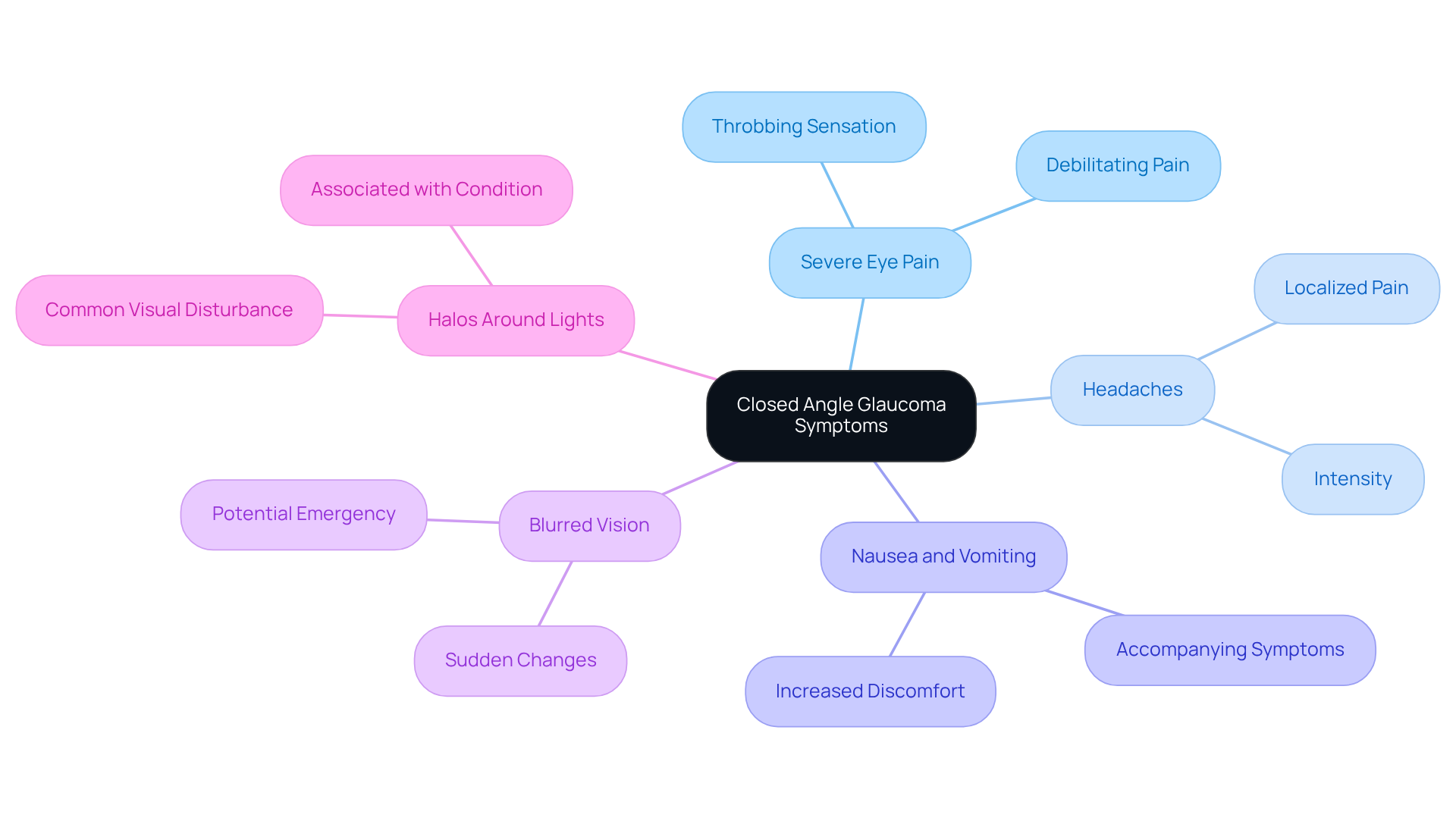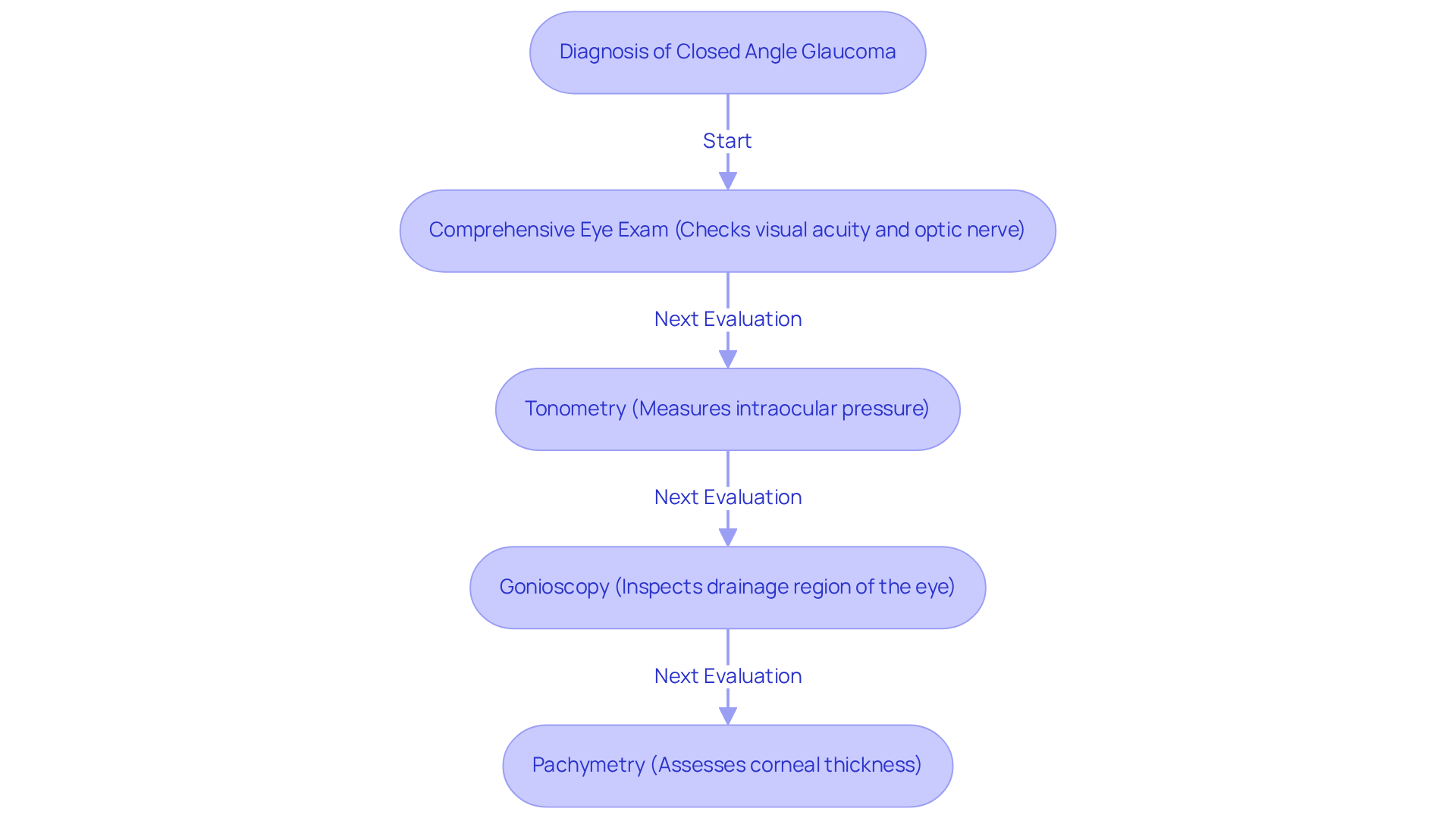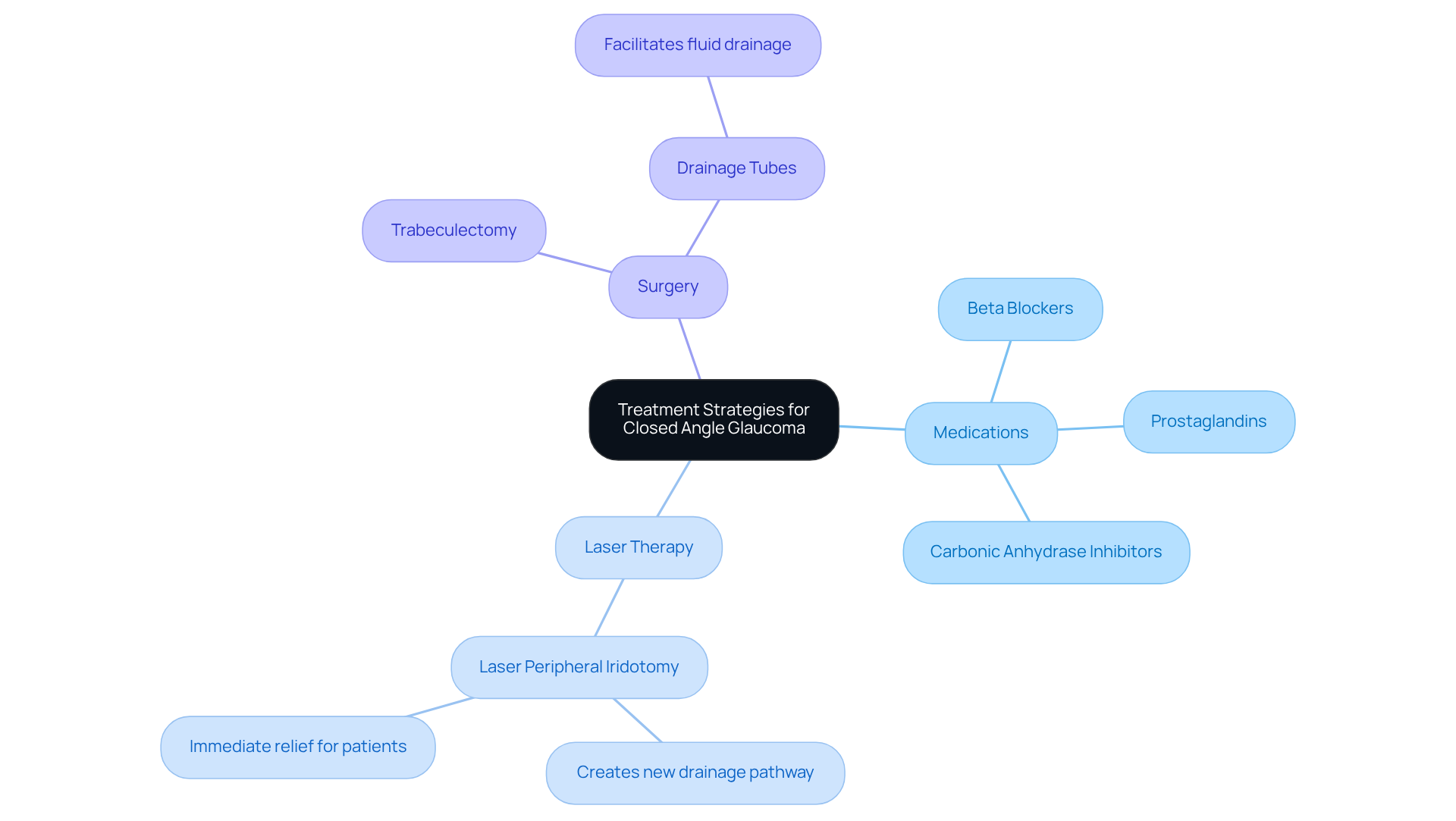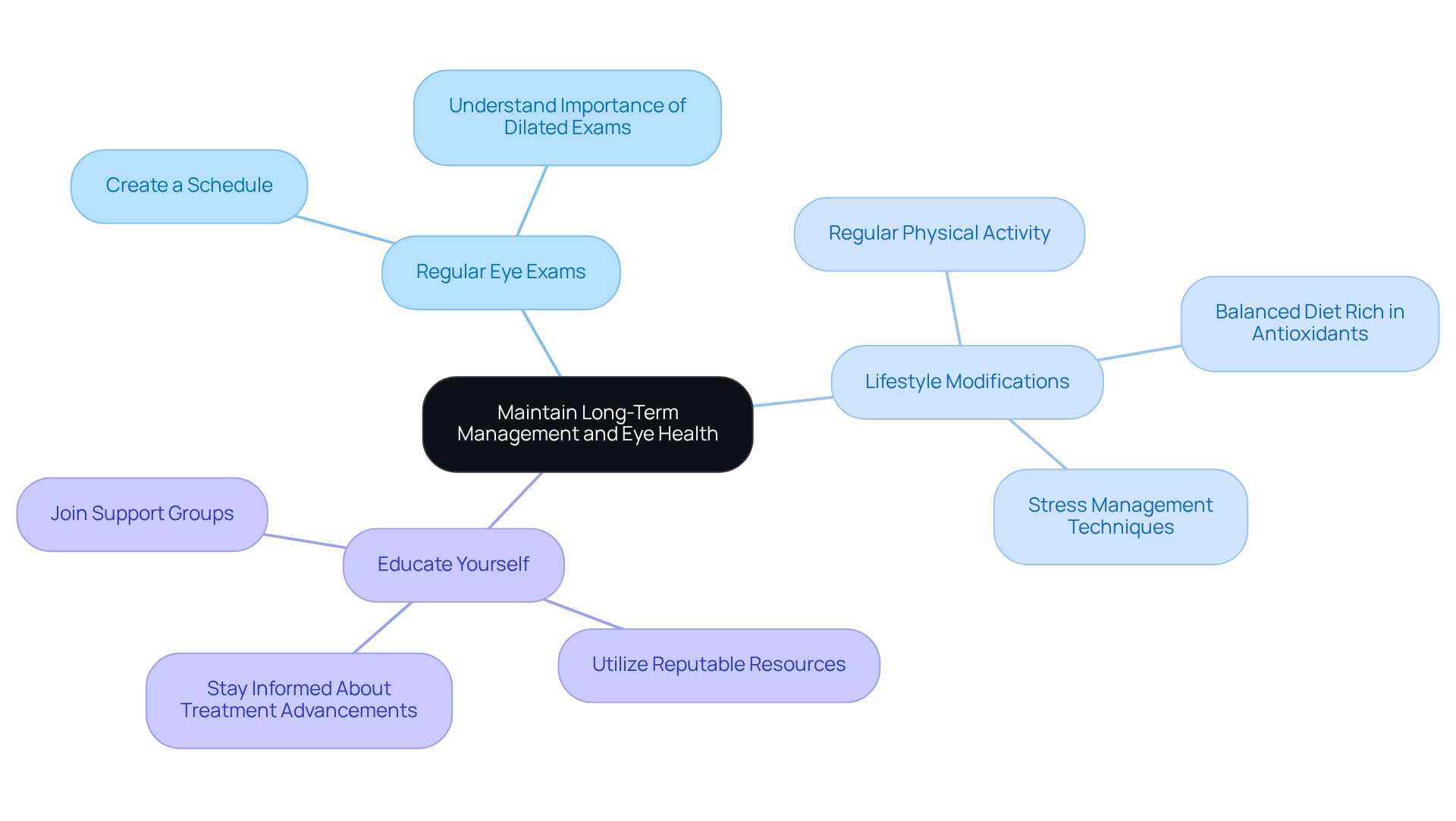Posted by: Northwest Eye in General, Glaucoma on July 31, 2025
Overview
This article outlines five key steps to effectively manage closed angle glaucoma. We understand that dealing with this condition can be overwhelming, so it’s important to approach it with care. The steps include:
- Understanding the condition
- Recognizing symptoms
- Diagnosing it
- Implementing treatment strategies
- Maintaining long-term eye health
Each step emphasizes the significance of early detection and appropriate medical intervention, which can help ease your concerns.
It’s common to feel anxious about potential vision loss, but please know that ongoing lifestyle modifications can make a significant difference in ensuring overall eye health. We are here to help you through this process, reinforcing that you are not alone in your journey. By following these steps, you can take proactive measures to protect your vision and maintain your well-being.
Introduction
Understanding the complexities of closed angle glaucoma is crucial. We recognize that this condition can lead to rapid vision loss if left unchecked, and it’s common to feel concerned about your eye health.
By exploring effective management strategies, you can gain valuable insights into maintaining your eye health and preventing irreversible damage. However, with various treatment options available, we understand that navigating the best path forward can feel overwhelming.
Together, we can ensure optimal outcomes for your vision.
Understand Closed Angle Glaucoma
Closed angle glaucoma occurs when the eye’s drainage pathway becomes blocked, resulting in a rapid increase in intraocular pressure. This condition can significantly impair vision if not treated promptly. It’s important to understand that anatomical factors, such as a shallow anterior chamber, play a crucial role in developing this condition. Additionally, certain medications that dilate the pupil can increase the risk.
We understand that grasping the structure of the eye can be daunting, but it’s essential for identifying the risk factors associated with narrow-angle eye disease. Familiarity with the drainage design can help you recognize potential problems early, giving you peace of mind.
Risk factors for closed angle glaucoma can vary depending on age and ethnicity. Older adults, particularly those of Asian descent, may face a higher risk of closed angle glaucoma due to anatomical predispositions. Furthermore, a family history of eye disease can increase susceptibility. It’s vital to be aware that the effects of this eye condition can differ among various ethnic groups, underscoring the importance of understanding these factors.
Awareness is key. Early detection and intervention can prevent irreversible damage to your vision. We encourage you to schedule routine eye check-ups and remain vigilant for significant signs of the condition between medical appointments. As Dr. Derek Welsbie, MD, PhD, emphasizes, “The tireless work of researchers continues to lead to a better understanding of eye diseases every day.” Staying informed about advancements in treatment options, such as the iDose® TR implant and the new eye drop medication Omlonti (omidenepag isopropyl), can provide reassurance as you navigate your eye health.

Identify Symptoms of Closed Angle Glaucoma
Recognizing the signs of closed angle glaucoma is essential for prompt action. We understand that experiencing sudden symptoms can be alarming. These symptoms may include:
- Severe Eye Pain: Patients often describe this pain as a throbbing sensation that can be debilitating.
- Headaches: These are typically localized around the forehead or temples and can be intense.
- Nausea and Vomiting: These symptoms frequently accompany the severe eye pain, adding to the discomfort.
- Blurred Vision: Sudden changes in vision clarity can occur, which may indicate a potential emergency involving closed angle glaucoma.
- Halos Around Lights: Many patients with closed angle glaucoma report seeing halos around lights, which is a common visual disturbance associated with this eye condition.
Studies show that a substantial portion of patients endure intense eye discomfort when affected by narrow-angle eye disease. This highlights the importance of identifying these signs. Ophthalmologists emphasize the importance of immediate medical attention if multiple symptoms are present, particularly for conditions like closed angle glaucoma, as prompt treatment can prevent irreversible damage.
Action Steps:
- Self-Assessment: If you experience any of these symptoms, especially in combination, we encourage you to seek medical attention immediately.
- Keep a Symptom Diary: Documenting occurrences can assist your healthcare provider in making an accurate diagnosis. Remember, we are here to help you through this process.

Diagnose Closed Angle Glaucoma
To diagnose closed angle glaucoma, we recognize that you may have concerns regarding your eye health. An ophthalmologist will typically perform the following evaluations:
- Comprehensive Eye Exam: This essential evaluation includes checking visual acuity and a thorough examination of the optic nerve, which is crucial for assessing overall eye health.
- Tonometry: This procedure measures intraocular pressure (IOP) to identify any elevated levels, a characteristic of this eye condition. In angle-closure eye disease patients, IOP is typically raised between 40 to 80 mm Hg, signaling the severity of the condition and the necessity for prompt intervention.
- Gonioscopy: Using a specialized lens, this method enables the ophthalmologist to inspect the drainage region of the eye, which is essential for diagnosing narrow-angle eye disease. This examination can reveal whether the angle is open or closed, providing vital information for treatment decisions.
- Pachymetry: This test assesses corneal thickness, which can affect the likelihood of developing eye pressure issues. Thinner corneas are frequently linked to an increased risk of eye pressure disease progression.
If you suspect that you have closed angle glaucoma, it’s common to feel anxious. Please schedule an appointment with your eye care provider for a comprehensive evaluation as soon as possible. Remember, closed angle glaucoma should be treated as an emergency to prevent permanent vision loss.
We encourage you to discuss any family history of eye diseases with your doctor, as this can significantly influence the diagnostic approach and urgency of your evaluation.
Recent developments in identifying narrow anterior chamber conditions highlight the significance of thorough eye examinations. Prompt detection is essential for avoiding vision impairment. Research supports the effectiveness of tonometry and gonioscopy in accurately diagnosing this condition, underscoring the need for regular eye check-ups, especially for those at risk. Additionally, managing acute angle-closure eye pressure requires a collaborative approach involving an ophthalmologist, family practitioner, ophthalmology nurse, and pharmacist to ensure optimal patient outcomes. We are here to help you through this process.

Implement Treatment Strategies for Closed Angle Glaucoma
Managing a narrow-angle eye condition can feel overwhelming, but applying effective treatment methods can be achieved through a comprehensive strategy that includes medications, laser treatment, and, in some cases, surgical procedures.
- Medications: To start, patients often receive prescription eye drops aimed at lowering intraocular pressure (IOP) and reducing inflammation. Common medications include beta blockers, prostaglandins (typically prescribed for once-a-day use), and carbonic anhydrase inhibitors. These are essential for managing symptoms and preventing complications. However, we understand that following medication regimens can be challenging; studies indicate a non-adherence rate of about 28.18% among patients with eye conditions, which can significantly impact treatment outcomes.
- Laser Therapy: Laser procedures, like laser peripheral iridotomy, are frequently used to create a new drainage pathway for aqueous humor, effectively lowering IOP. This minimally invasive technique has shown promising results in alleviating closed angle glaucoma eye pressure, with many patients experiencing immediate relief. It’s important to note that if an acute angle-closure episode occurs in one eye, laser iridotomy is usually performed on both eyes to prevent recurrence. Recent advancements in laser technology continue to enhance the effectiveness of these treatments, solidifying their role as a cornerstone in managing eye pressure.
- Surgery: In certain situations, surgical intervention may be necessary to address anatomical issues contributing to the condition. Options can include trabeculectomy or the insertion of drainage tubes, which help facilitate fluid drainage and reduce IOP.
By adhering to recommended treatment strategies, maintaining open communication with your healthcare providers, and participating in routine eye examinations to monitor risks, you can effectively manage narrow-angle eye conditions and protect your sight. We want to emphasize that immediate treatment is crucial for acute cases to prevent vision loss, and it’s essential to be aware of potential complications from treatments, such as blurred vision and light sensitivity for a few days post-procedure. Remember, we are here to help you through this process.

Maintain Long-Term Management and Eye Health
To effectively manage closed angle glaucoma over the long term, consider the following strategies:
- Regular Eye Exams: We understand that keeping track of your eye health can feel overwhelming. However, consistent follow-ups with your ophthalmologist are essential for monitoring eye health and intraocular pressure. Regular eye exams not only help maintain your vision but also detect conditions like closed angle glaucoma that may require immediate attention. Statistics indicate that 74% of participants stated they had their eyes checked at least every two years, but only 43% had experienced dilated eye exams, which are crucial for identifying eye conditions. As emphasized by eye care professionals, understanding your eyesight is vital for your overall health and quality of life. Lisa M. Young, OD, FAAO, states, “Regular eye exams not only keep your vision sharp but also detect signs of systemic health conditions like diabetes and high blood pressure.”
- Lifestyle Modifications: It’s common to feel that managing your health is a daunting task. Adopting a healthy lifestyle can significantly impact your eye health. Focus on a balanced diet rich in antioxidants, engage in regular physical activity, and practice stress management techniques. Research shows that lifestyle modifications can improve the management of eye conditions, including closed angle glaucoma, potentially slowing disease progression and enhancing overall well-being. Incorporating these changes is vital for your long-term eye health.
- Educate Yourself: We believe that knowledge is empowering. Staying informed about glaucoma and its management options is essential. Utilize reputable resources, such as the Eye Condition Library and symptom checkers available at Northwest Eye, to understand your condition better and explore new treatment advancements. This knowledge empowers you to make informed decisions about your eye care.
Action Steps:
- Create a Schedule: We encourage you to set reminders for your regular eye exams and ensure you adhere to them for optimal monitoring. This proactive measure is essential for maintaining your eye health.
- Join Support Groups: Connecting with others who share similar experiences can provide emotional support and valuable insights into managing your condition. We are here to help you through this process.

Conclusion
Understanding and managing closed angle glaucoma is crucial for preserving your vision and overall eye health. We recognize that navigating this condition can be daunting, and that’s why this guide has highlighted the importance of:
- Recognizing symptoms
- Seeking prompt diagnosis
- Implementing effective treatment strategies
By being proactive and informed, you can significantly reduce the risk of irreversible damage caused by this serious eye condition.
Regular eye exams are essential. Identifying risk factors and exploring various treatment options—such as medications, laser therapy, and surgical interventions—can empower you in this journey. We also want to emphasize the importance of:
- Lifestyle modifications
- Ongoing education
These elements are vital for effective long-term management of closed angle glaucoma.
Taking charge of your eye health is a vital step in preventing vision loss. We encourage you to remain vigilant about your symptoms, adhere to your treatment plans, and engage in regular check-ups with your eye care professionals. By fostering a proactive attitude towards your eye health, you can navigate the challenges of closed angle glaucoma and maintain a clearer vision for the future. Remember, we are here to help you through this process.
Frequently Asked Questions
What is closed angle glaucoma?
Closed angle glaucoma occurs when the eye’s drainage pathway becomes blocked, leading to a rapid increase in intraocular pressure, which can significantly impair vision if not treated promptly.
What anatomical factors contribute to closed angle glaucoma?
Anatomical factors such as a shallow anterior chamber play a crucial role in developing closed angle glaucoma.
What medications can increase the risk of closed angle glaucoma?
Certain medications that dilate the pupil can increase the risk of developing closed angle glaucoma.
Who is at higher risk for closed angle glaucoma?
Older adults, particularly those of Asian descent, may face a higher risk due to anatomical predispositions. A family history of eye disease can also increase susceptibility.
How can awareness and early detection help with closed angle glaucoma?
Awareness is key, as early detection and intervention can prevent irreversible damage to vision. Routine eye check-ups and vigilance for significant signs are essential.
What are the symptoms of closed angle glaucoma?
Symptoms may include severe eye pain, headaches, nausea and vomiting, blurred vision, and halos around lights.
What should I do if I experience symptoms of closed angle glaucoma?
If you experience any of these symptoms, especially in combination, seek medical attention immediately.
How can keeping a symptom diary help in diagnosing closed angle glaucoma?
Documenting occurrences of symptoms can assist your healthcare provider in making an accurate diagnosis.
What advancements in treatment options are available for closed angle glaucoma?
Advancements include the iDose® TR implant and the new eye drop medication Omlonti (omidenepag isopropyl). Staying informed about these options can provide reassurance regarding eye health.






